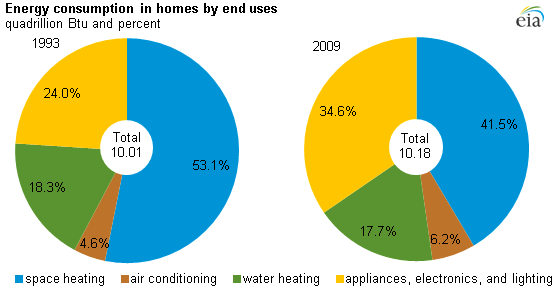By Claire Miziolek | Thu, March 28, 13
The world of consumer electronics is vast and complex. There are devices that we think about every day, such as our computers, televisions, or (for some) game consoles. Then there are the electronics that we tend to forget, such as that cable box that’s always on, or the router providing password-protected wi-fi to our homes 24/7. Or what about that desktop that’s been gathering dust at your home or office? When was the last time you checked to make sure that the monitor was actually turned off?
 Comparison of Energy Consumption in Homes by End Uses between 1993 and 2009
In many ways, the average American household has dramatically improved in efficiency. Thanks to many years of hard work, some of the largest home energy hogs such as heating or lighting are much more efficient. But while energy use for many aspects of the home has decreased, the share of energy used by electronics has grown. According to the EPA, consumer electronics are responsible for 15% of household energy use, with an average household owning 25 consumer electronic products. While the kilowatt-hour energy implications for each device is relatively low, with 25 devices and growing in each home, the impact of consumer electronics really adds up.
Think of it: in 1978, the average American household had only 1 TV. By 2009, that number had climbed up 2.5 (while the number of US households had grown by 34.5 million), and by 2012 there was an average of 2.9 TVs in each US household! Not to mention the internet enabled devices such as tablets, smart phones, or laptops that didn’t exist in 1978. There has been a trend toward smaller screened electronics (i.e. from TV to laptop to tablet to smartphone) which is beneficial in terms of efficiency as a smaller screen sizes usually translates to less energy used. However, the number of these devices is growing in leaps and bounds, and if we don’t start paying attention to their efficiency (the ways appliances such as radiators, refrigerators, and water heaters have), this problem will also grow.
Technology evolves incredibly quickly, and many of the tools in the energy efficiency toolbox such as utility incentives and standards struggle to keep up. To help tackle this problem, NEEP is undertaking a project to create a strategy with recommendations that the Northeast Mid-Atlantic region can use to gain efficiency in consumer electronics. We will be communicating through regular blog updates, the final strategy (to be released end of summer, 2013) and the Consumer Electronics workshop on June 18th at the NEEP Summit. We hope to see you there!
If you’d like to learn more about NEEP’s Business and Consumer Electronics Strategy, please email Claire Miziolek at cmiziolek@neep.org
Comparison of Energy Consumption in Homes by End Uses between 1993 and 2009
In many ways, the average American household has dramatically improved in efficiency. Thanks to many years of hard work, some of the largest home energy hogs such as heating or lighting are much more efficient. But while energy use for many aspects of the home has decreased, the share of energy used by electronics has grown. According to the EPA, consumer electronics are responsible for 15% of household energy use, with an average household owning 25 consumer electronic products. While the kilowatt-hour energy implications for each device is relatively low, with 25 devices and growing in each home, the impact of consumer electronics really adds up.
Think of it: in 1978, the average American household had only 1 TV. By 2009, that number had climbed up 2.5 (while the number of US households had grown by 34.5 million), and by 2012 there was an average of 2.9 TVs in each US household! Not to mention the internet enabled devices such as tablets, smart phones, or laptops that didn’t exist in 1978. There has been a trend toward smaller screened electronics (i.e. from TV to laptop to tablet to smartphone) which is beneficial in terms of efficiency as a smaller screen sizes usually translates to less energy used. However, the number of these devices is growing in leaps and bounds, and if we don’t start paying attention to their efficiency (the ways appliances such as radiators, refrigerators, and water heaters have), this problem will also grow.
Technology evolves incredibly quickly, and many of the tools in the energy efficiency toolbox such as utility incentives and standards struggle to keep up. To help tackle this problem, NEEP is undertaking a project to create a strategy with recommendations that the Northeast Mid-Atlantic region can use to gain efficiency in consumer electronics. We will be communicating through regular blog updates, the final strategy (to be released end of summer, 2013) and the Consumer Electronics workshop on June 18th at the NEEP Summit. We hope to see you there!
If you’d like to learn more about NEEP’s Business and Consumer Electronics Strategy, please email Claire Miziolek at cmiziolek@neep.org
 Comparison of Energy Consumption in Homes by End Uses between 1993 and 2009
Comparison of Energy Consumption in Homes by End Uses between 1993 and 2009